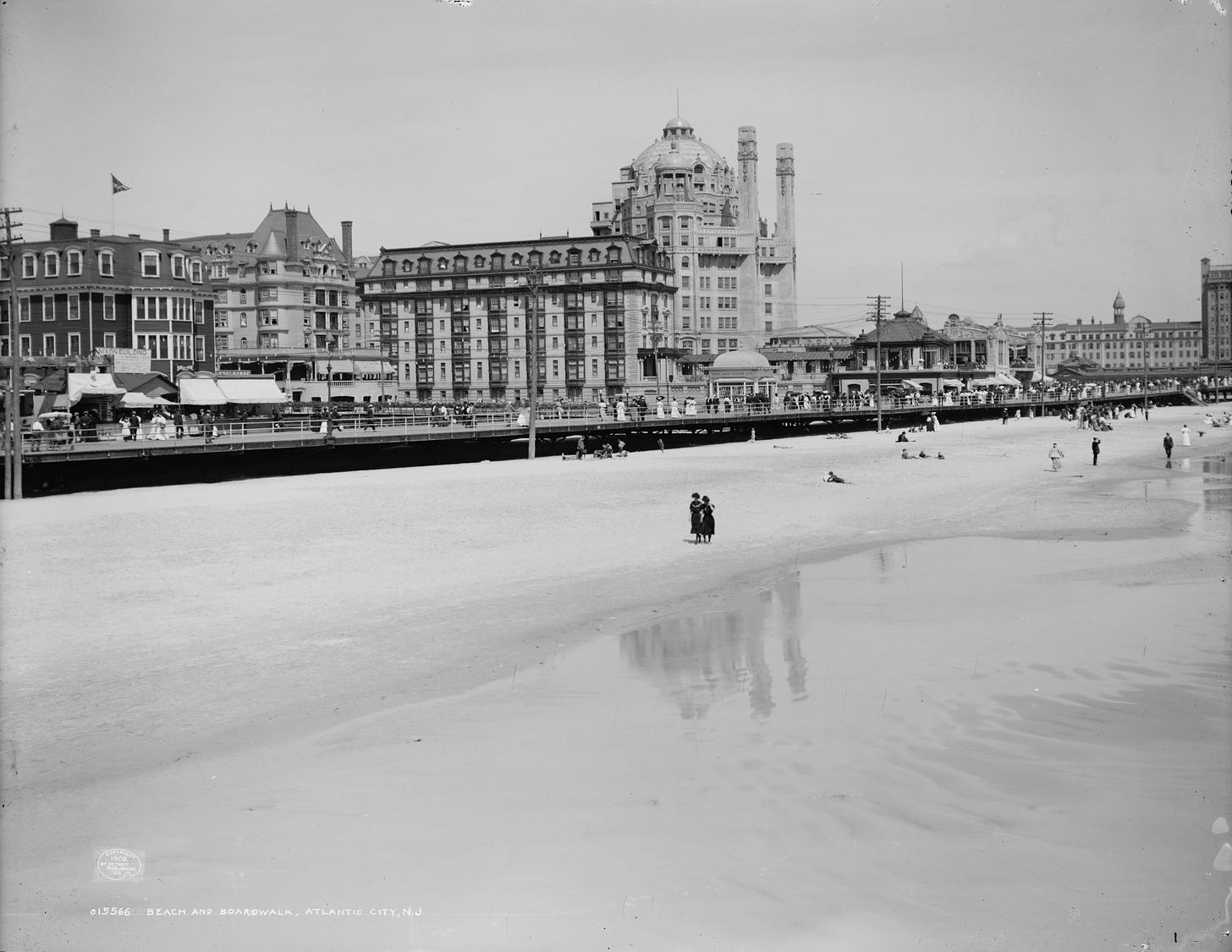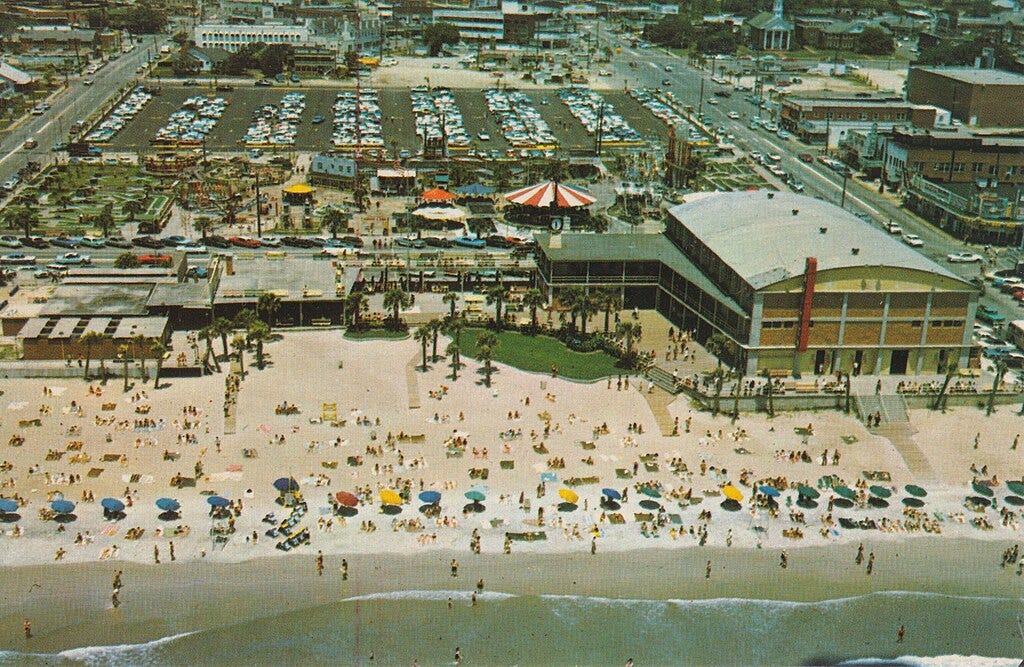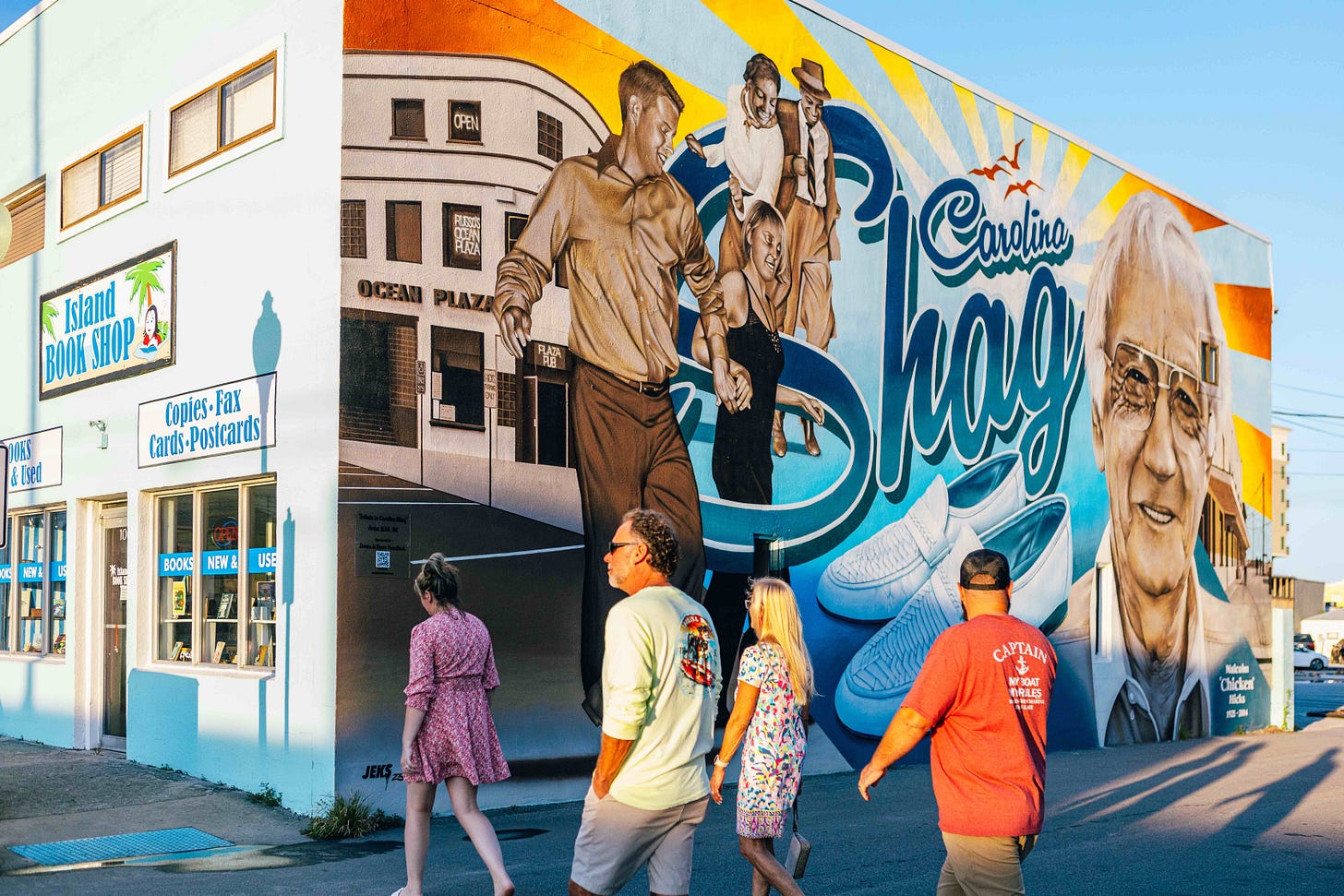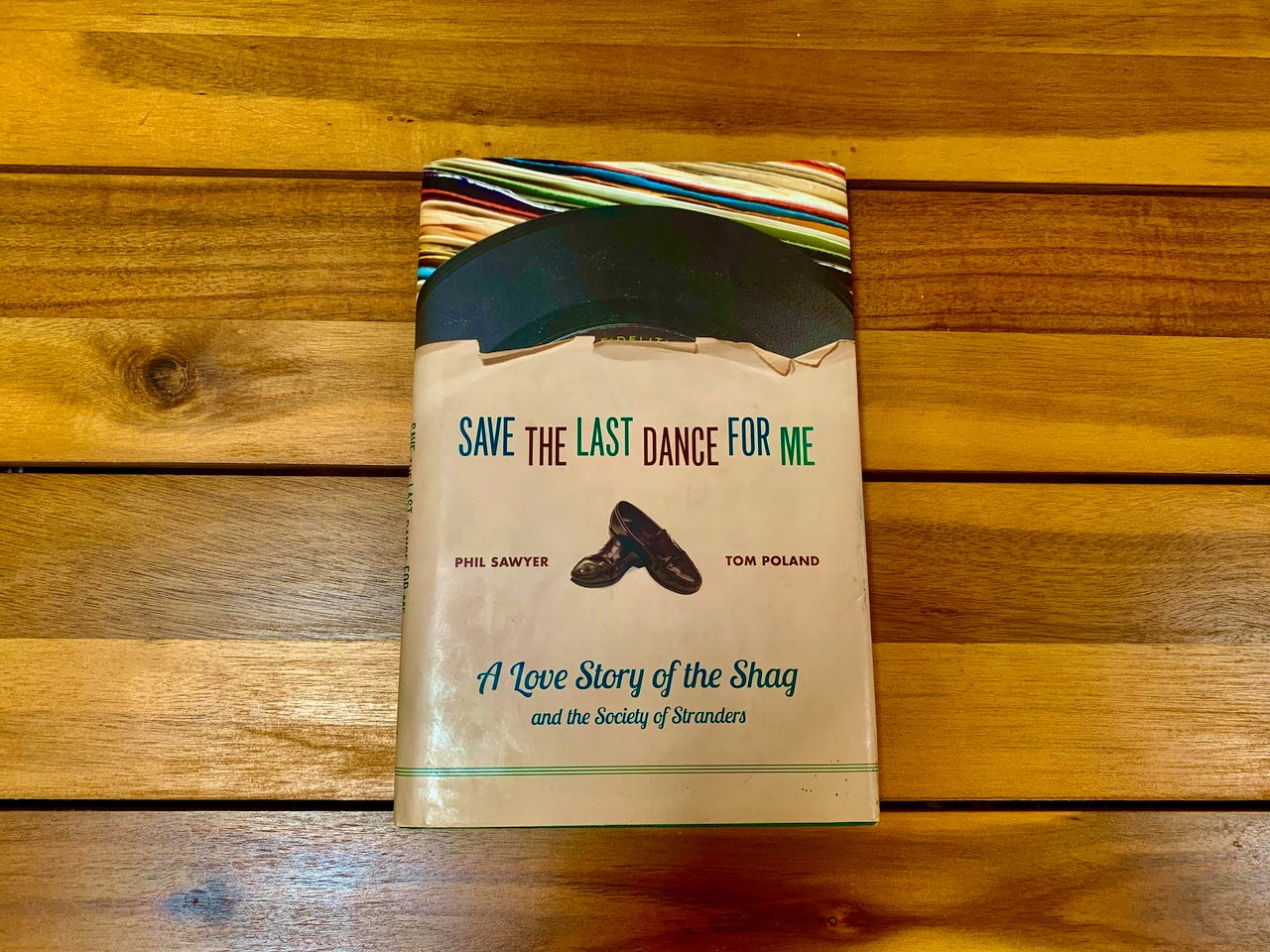Coastal Nostalgia 🏖️
The First Boardwalk, Myrtle Beach, and the Carolina Shag
By Elizabeth Poland Shugg

Our “Vintage Summer” feature invites you to re-experience the cherished places and pastimes of your youth.
If some of your favorite memories involve carefree—and sand-free—strolls along one of America’s historic beach boardwalks, you’re in luck. We have access to some of the country’s finest here in the Southeast. Restaurants, bars, musicians, and vendors offering cold refreshments, sweet treats, beach apparel, and other products flank these wooden—or concrete—walkways, which beachgoers also use for shopping, cycling, running, and dog walking.
The First Boardwalk
America’s first boardwalk opened in Atlantic City, New Jersey, on June 26, 1870, in response to the town’s growing popularity as a resort destination. Several hoteliers and businessmen had petitioned the city to construct a wooden footwalk that would prevent sand from being tracked into hotel lobbies and other businesses along the beach.
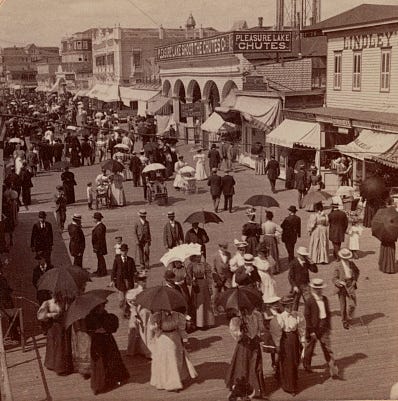
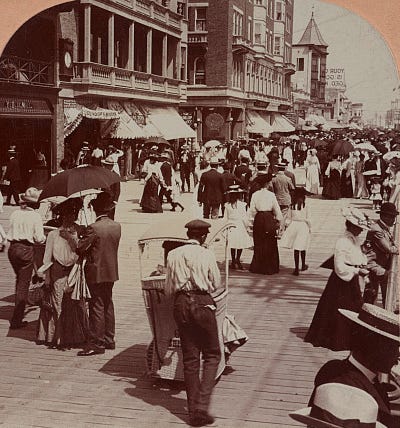
Council members approved the request and offered $5,000 in support of the project, which paid for construction of a 1-mile walkway made with 8-foot-wide wooden boards positioned 1 foot above the sand. Back then, the original boardwalk was removed and stored at the end of each beach season. Later versions became more permanent. The Atlantic Beach boardwalk paved the way, so to speak, for construction of beach boardwalks around the country.
South Carolina Walks the Plank
The Myrtle Beach Boardwalk and Promenade was constructed a little over sixty years later on South Carolina’s coast, and is now considered one of the Southeast’s most popular boardwalks. Let’s take a closer look at its history, and how this iconic destination has changed over the years.
The Original
Myrtle Beach’s original boardwalk was constructed with wooden planks during the 1930s.1 All the good stuff—dance halls, attractions, the popular Pavilion, and family hotels—could be found along the boardwalk by that time. Unfortunately in 1954, Hurricane Hazel barreled through the area, destroying the original boardwalk and most of Myrtle Beach’s dance halls. A concrete pathway was constructed in its place that still exists today.2
More bad news arrived in 2006 when Pavilion owners Burroughs & Chapin announced they would be closing the amusement facility due to financial challenges. Demolition began in 2007 and some of the rides were relocated to the Pavilion Nostalgia Park at Broadway at the Beach, which opened later that year.
The Pavilion’s closing opened up the opportunity for change. Myrtle Beach’s town council voted to upgrade the boardwalk that year, and in summer 2010, the dog-friendly Myrtle Beach Boardwalk & Promenade opened.
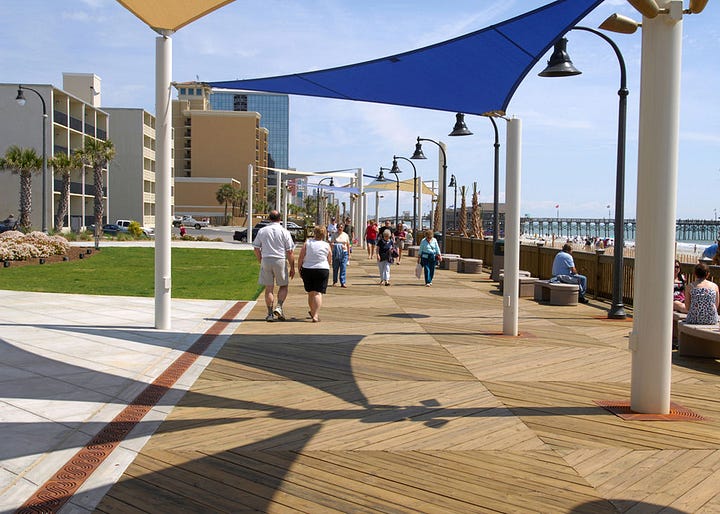
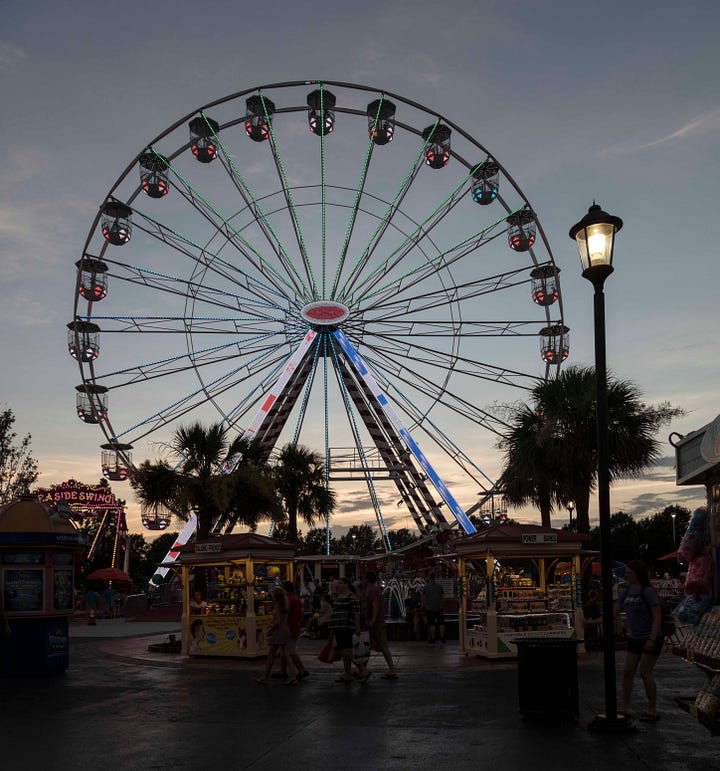
Most attractions stay open 11 a.m. to 11 p.m. along the boardwalk, which now spans 1.2 miles—from Pier 14 south toward the Second Avenue Pier. The new boardwalk offers live music, weekly summer firework shows, and a 187-foot-high Myrtle Beach SkyWheel. Early risers are sometimes rewarded with the opportunity to take a sunrise flight on the SkyWheel, which provides expansive views of the Atlantic.
The Carolina Shag
As construction continued on the original Myrtle Beach boardwalk during the 1930s, the Carolina Shag took hold of North Myrtle Beach’s African American community along Ocean Drive. Also referred to as the “swing dance of the South,” interest increased in this cultural phenomenon and the beach music accompanying it, attracting a broader audience to the area during the 1940s that included World War II soldiers on leave or stationed nearby.
Over the next forty years the Shag became so popular, South Carolina named it the official state dance in 1984. North Carolina followed suit in 2005 by naming it the state’s official “popular dance” (clogging was selected as the Tar Heel state’s official folk dance).
Tom Poland’s book, Save the Last Dance for Me, shares the history of the Shag and Society of Stranders. Poland explains that music played a key role in boosting the Shag’s popularity.
“Want to start a spirited conversation? Ask a group of shaggers how and when the shag began … Some say it rolled off the Mississippi, a mist that mesmerized all who breathed it. Others say it shot up from the river’s alluvial plan, the Mississippi Delta. Something mystical, something melancholy came out of the delta all right—the blues, that sadly beautiful, beautifully sad music. And the blues, that mighty tributary of melody that grew out of work songs, spirituals, shouts, and chants, would shape shaggers’ music.”
— Tom Poland, Save the Last Dance for Me
Songs like “Sixty Minute Man” by The Dominoes (1951), “Ms. Grace” by The Tymes (1974), and “Carolina Girls” by Chairman of the Board (1980) are all hallmarks of Shag music’s evolution over the past seventy-plus years.
Missing Myrtle
Myrtle Beach fans who miss the Ocean Drive dance halls, original boardwalk, and other vintage attractions have created a Myrtle Beach Back Then Facebook page. Scroll through it to see old photos of the magnificent Ocean Forest Hotel, The Helms, the Myrtle Beach National Wax Museum, the Gay Dolphin Gift Shop, Mother Fletchers, the Pavilion, and a 1970s photo of The Pad in North Myrtle Beach—considered the birthplace of the Shag.
Those of you who vacationed at Myrtle Beach up through the 1990s will probably connect with these “10 Memories Celebrating the Old Myrtle Beach,” such as riding the Hurricane at the Pavilion, dancing at Mother Fletchers, and attending the Sun Fun Festival.

Be sure to also check out Myrtle Beach Remembered, a website devoted to memories of Myrtle Beach during the ’80s and ’90s. Site creator Wayne Aiken presents an intriguing collection of old Myrtle Beach photos and a map showing where previous hotels, restaurants, and attractions were located.
Southeastern Boardwalks
If you’re vacationing near one of these boardwalks this summer, save time for a stroll along its coastal pathway.
Glory Beach Boardwalk
Jekyll Island, Georgia
0.1 mile
Myrtle Beach Boardwalk and Promenade
Myrtle Beach, South Carolina
1.2 miles long
Shem Creek Boardwalk
Mount Pleasant, South Carolina
.4 miles
Carolina Beach Boardwalk
Carolina Beach, North Carolina
About 300 feet
Duck Town Park Boardwalk
Duck, North Carolina
.64 mile
Manteo Boardwalk
Manteo, North Carolina
1.25 miles
Virginia Beach Boardwalk
Virginia Beach, Virginia
3 miles
If you missed our Summer 2024 issue email, check it out here. Ready to subscribe to our print issue? Order your subscription here. And don’t forget to enter our Designed for Joy giveaway!
Some sources say the first segment of the wooden boardwalk was actually built in 1923.
The same source in footnote 1 says the boardwalk was replaced with concrete in 1938.



